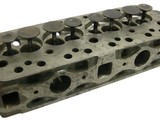
Last time we started building a small-bore engine for maximum power. But there is no point having a good engine and putting the wrong head on it.
I'm going to use the 12G202 head, as these are the best to modify for our purposes. They are a bit smaller than the 12G295 or 12G206 heads, which gives you a bit more metal to play with when grinding. As far as a standard head goes, you can't go past the 12G295 or 12G206.
I do not like the use of the 1275-type heads (12G940, etc) as these are too big for the small-bore motors. Yes, they will make the horsepower if you rev them hard enough, but I can still make more horsepower, with a better spread of torque, using the smaller heads.
The smaller heads have much better airspeed and better filling, which in turn produces a better spread of torque throughout the rev range - and it is torque that accelerates the car. When using 1.218" valves the 295 head flows the same as the 940 head with 1.3", but the 295 head is doing it with smaller volume right through.
To give an example, let's look at the 970S and 998 Cooper motors. The 970S uses a Mk1 Cooper S head, with smaller combustion chambers - therefore higher compression - and larger inlet valves. Both engines make the same torque - 57 ft lbs - but the 998 Cooper engine makes this at 3,000 rpm, while the 970S engine makes it at 5,000 rpm - some 2,000rpm higher. My point is, bigger is not always better.
As an aside, there was a one-off type of engine, of which only around 40 were made, built for John Cooper's Formula Junior race cars. It is not well known, but worth having a look at. This was based on a 950cc A-series block, with a bore of 2.661" (67.6mm) and stroke of 3" (76.2mm) - giving a capacity of 1095cc - and produced 98 hp at 7,800 rpm with a 40mm Weber. The first version used a smaller cam and twin SU carbs, and produced 94hp.
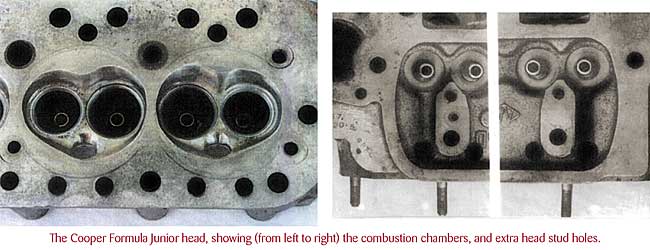
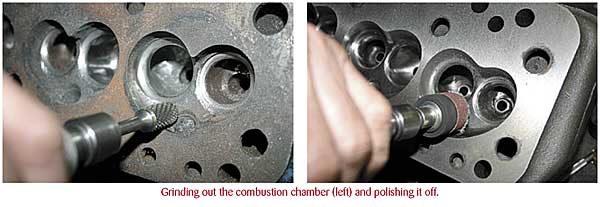
It was dry-sumped and had special rods, but the best part was the cylinder head (see page 70). This engine had a small-bore head (with two casting numbers - AEA626 and 12A185) which was almost the same as the 12G295 head. But, it had slightly bigger valves (both inlet and exhaust). More importantly, it had two extra head studs, one at each end, like the Cooper S heads, to prevent blowing the head gasket.
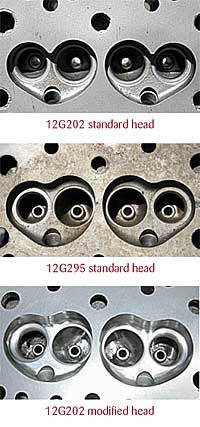 Getting back to our project motor, I have modified the combustion chambers on our 202 Head, ported it out and fitted bigger valves - 1.280" inlet and 1.062" exhaust. Be careful not to overdo the porting. You don't need to go any bigger than on a 12G295 head. In fact, with a bit of cleaning up of the inlet ports, the 202 head is ideal for a road car.
Getting back to our project motor, I have modified the combustion chambers on our 202 Head, ported it out and fitted bigger valves - 1.280" inlet and 1.062" exhaust. Be careful not to overdo the porting. You don't need to go any bigger than on a 12G295 head. In fact, with a bit of cleaning up of the inlet ports, the 202 head is ideal for a road car.
With a decent manifold and 1.75" SU carb fitted, this modified head has a good high gas flow of 115 cubic feet per minute (cfm) @ 25", compared with the standard head at 70cfm.
This brings me to the importance of a good manifold. It is no good having a well-ported head and then putting a poor-fl owing manifold on it, as the manifold is really just an extension of the inlet ports. If the manifold doesn't flow efficiently then you have just wasted time and money on doing the head. I've seen some manifolds drop the airflow of a good Cooper S head by as much as 20%.
The length of the manifold is also a consideration, and here longer IS better. In this I am talking only about the length of the manifold. Don't think that long ram tubes fitted with a short manifold will be as good, because they won't. The critical length when dealing with carburettors is the distance from the valve to where the fuel enters the air-flow. This, of course, is not the case with fuel-injection.
So, the two things you need for a good manifold are length and volume. The Weber manifold and SU manifold that I make are both a tight squeeze under the bonnet, but they are designed for performance, not looks. My Weber manifold is about 5.25" (133mm) long, but has a very large volume for its size. My SU manifold has both volume and length - around 7" (178mm) along the centre-line of the manifold - and makes good torque on any size engine.
The old "Swan-neck" Weber manifold is disliked by many people, but it is actually not a bad manifold, if you are not after maximum torque and horsepower. So, if you are wanting a nice, mild engine, you don't have to put the same type of manifold on, that you would use if looking for say 150hp. I've seen 90hp with these manifolds, which still makes for a lively road car.
"We regularly get asked what is the "best" Weber manifold to fit to your A-series engine. I admit I'm biased, and I do have a favourite, but largely it also depends on what you want to define as "best". Certainly "best" has to include "fit for the purpose" and in that context you have to consider whether the manifold actually does fit. Some manifolds made for Sprites and Midgets don't really fit a Mini, and some made nicely for a Mini don't produce the best results for a Sprite/Midget.
Anyway, a little bored and wanting some concrete statistics, I gathered up all the manifolds I could find and wandered off for a scientific test on a flow bench. For the purpose of this exercise, I will define "best" as the one that produces the highest cfm (cubic feet per minute) of airflow at a partial vacuum of 25 inches of water (which I believe is the "standard" of measurement).
Now, let's start with a little theory (sorry). Engines need fuel and air mixed in the correct ratio to ignite efficiently, and the more of this mix you can deliver to the engine, the more power the engine is theoretically capable of producing. The actual power output of the engine depends of course on many more factors which will include cylinder head design, camshaft profile and timing, valve size and lift, exhaust system, and compression ratio. A fairly standard 948cc engine might produce maximum power using only a moderately effective carby and inlet manifold. However, as your engine increases in capacity and performance capability, so it needs more fuel/air to enable it to produce the best results. So it is fair to say that the manifold that flows the most air, is CAPABLE of producing the most power.
We had five manifolds on hand, and I know this doesn't represent all the ones available world-wide. However, they would be the ones most used in Australia. They can be described as follows, but sorry if I don't include your favourite manifold (nope, no Cannon ones were available).
Man A: LYNX Mini manifold, steeply upswept "swan-neck". Fits easily in a Mini, which is why it was designed that way. Commonly accepted as a poor performer. Man B: LYNX fl at 5" A-series manifold. Fits a Sprite or Midget, will not fi t a Mini without cutting a hole in the firewall. Man C: Warneford or Redline 5" manifold. Upswept to clear the firewall of a Mini, also fi ts nicely in a Sprite/Midget. Man D: Warneford or Redline 6" manifold, longer (duh!) and not so upswept. Needs firewall modification to fit a Mini. Weber comes VERY close to the inner mudguard on Sprite/Midget. Man E: Limited-production hand-finished 5" cast manifold from Russell Engineering. Fits comfortably in either Sprite/Midget or Mini. And so to the results of the shoot-out.
Man A: (LYNX Mini) - 104 cfm
Man B: (LYNX 5") - 136 cfm
Man C: (Warneford 5") - 139 cfm
Man D: (Warneford 6") - 175 cfm
Man E: (RE 5") - 242 cfm (Graham Russell's SU manifold was flow tested in the UK and produced 207 cfm @ 25" - Ed)I had two people suggest that we re-run the tests, but this time with the manifolds attached to a cylinder head. That way we could see the extent to which the manifolds hindered air flow into the head. Well, that sounded like a really good idea, so that's just what we did. We grabbed a nicely modified 12G940 head from a 1275cc engine, with good porting etc, and 1.4" inlet valves, set it up on the flow bench, and took readings with and without manifolds. We didn't bother testing the two poorest performing manifolds as we really weren't interested in the result.
I have to admit, the results weren't exactly what I was expecting. I knew the raw numbers would change, but I wasn't expecting any change in the order of ranking of the manifolds - but that is what happened. We re-ran the test just to check, and nothing changed. All tests were done with the same vacuum as previously, and with .500" of valve lift. That's about the lift you would get with a performance camshaft and 1.5:1 rockers.
146 cfm through the head alone
144 cfm (2 cfm or 1% drop) with the RE
131 cfm (15 cfm or 10% drop) with the 6" Warneford/Redline
130 cfm (16cfm or 11% drop) with the Maniflow
113 cfm (33 cfm or 23% drop) with the 5" Warneford/RedlineJust for the hell of it, we also attached the RE single SU manifold, and it flowed 141 cfm (5 cfm or 3% drop). And that was WITH a 1.75" SU attached to the manifold!
Now, nothing sounds quite like a Weber, but there are more important things than how it sounds. You can still get the same horsepower from an SU, but for racing conditions a Weber is more drivable. For normal road use, even if you are a bit of a "Boy Racer", the SU is great. It is also a lot quieter than the Weber, possibly more economical and a lot less smelly, which is all the better if you are driving your Mini a fair bit. Still, if you really have to have that Weber sound then there is no comparison.
It is very important to remember what you are building the motor for. If it s going to be a daily driver, or used for weekend cruises, then build it for that. Don't go overboard with a big head, lumpy cam, manifold and exhaust which would be more suited to a race engine. Instead, aim to get a good spread of torque from low down. It will be much better to drive than a motor which doesn't start to make power until around 4,500-5,000rpm.
When I build race engines I still chase torque as the most important factor. Getting out of corners quickly and accelerating away is more important in most racing than outright top speed. When it comes to top speed in a Mini, I've done a lot of testing with a GPS (no chance for tacho, tyres or other variables to throw out the results) and, without a doubt, a Mini on narrow tyres and no flares, with 145-150hp, will not go over about 123mph on a flat road. But, a similar Mini with 115- 120hp will still do 118-120mph.
This is because of the drag that is inherent in the design of the Mini body, and it takes a massive amount of horsepower to overcome this. Yes, Minis have recorded faster speeds at Bathurst, but that is on Conrod Straight, which is down hill! I would happily sacrifice 10-15hp in the interest of getting an extra 5-7 ft lbs of torque.
So, with our head complete, and our choice of manifold sorted out, we need to look at fitting the head and setting the valve timing. As I mentioned in the last issue, when timing the camshaft I always have the head fitted, to put tension on the chain or belt.
Before fitting the rocker gear, I'll make a quick point on what sort of gear to use. Unless you are looking for power above 5,500rpm then do not use rockers with a ratio greater than 1.3:1, as they will cost you power and torque. When fitting the rocker gear, make sure that the rocker pad is centred on the valve tip when the valve is on half lift.
Now, with the head on the engine and the rocker gear fitted and adjusted, it is important with a performance engine to get the valve timing the same for all valves. By this I mean, when the valves actually start to open, and it has nothing to do with ignition timing.
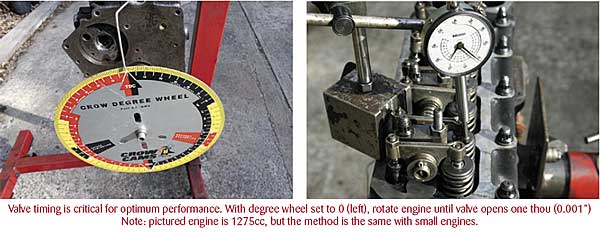
To do this we need to use a dial indicator on the valve cap and a degree wheel on the crankshaft. With number one cylinder at Top Dead Centre (TDC) on the firing stroke, set the pointer on the degree wheel to Zero.
Now, rotate the engine and check the opening point on number one valve. That is when the dial indicator just starts to move by about one-thou. Repeat this process for the other three inlet valves.
You may find that three of the valves open at say 35 Before Top Dead Centre (BTDC), and one opens at 29 BTDC. This often happens with Mini rockers, both standard and after-market. You may get a bit of a shock when you start checking them.
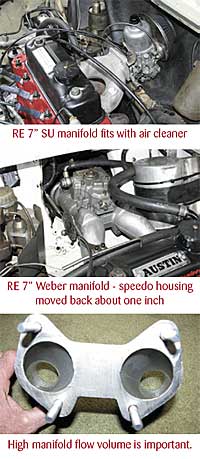 To get the 29 valve to open at 35 you may have to close the tappet up, so that it is set at say 0.012" rather than 0.016". Don't worry about the difference in settings as it is more important to get all the valve timings the same.
To get the 29 valve to open at 35 you may have to close the tappet up, so that it is set at say 0.012" rather than 0.016". Don't worry about the difference in settings as it is more important to get all the valve timings the same.
On some big-power engines I've had tappet clearances vary from 0.015" to 0.023" on the one engine. Remember, get the valve timing the same and you will make more power. If you are a little surprised about this variance, remember there are four factors that can change the tappet clearance. These are the radius on the cam-followers, the length of the pushrod, the length of the tappet adjuster and the ratio of the rocker.
I can't stress enough the importance of getting these valve timings the same. A difference of 0.002" can mean a loss of three to four ft lbs of torque across the rev range. The ratio of rockers is also a bit of a concern. As I said, unless you after power above 5,500rpm, there is no need to use greater than 1.3:1.
Some rockers which are sold as 1.5:1, both roller rockers and forged rockers, are actually measuring 1.6:1 and higher. This creates a lot of problems with valve timing and lift. Some cams I am aware of are giving 330 duration, instead of the nominated 280, and instead of the rated 0.480" lift have 0.520" - 0.530" lift. This is because the rockers are a higher ratio than stated, so are accelerating faster onto the valve, which in turn gives longer duration and higher lift. This can be corrected by opening up the tappet clearance.
I have found that with 1300cc - 1480cc A-series race engines you don't need more than about 0.480" - 0.500" lift, and with small-bore engines, like the one we are looking at, 0.400" - 0.450" is adequate.
So, now we have the head on the engine, the rocker gear and valve timing sorted, and we've decided on the inlet manifold and carburettor.
Next issue we will be putting the engine on the dyno and running a series of tests with a variety of exhaust extractors, inlet manifolds and carburettors, and should be able to prove most of the things I've mentioned this time around.
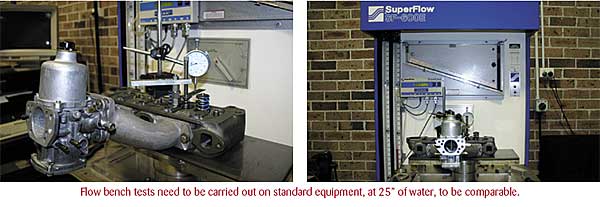
Reprinted with permission from www.miniexperience.com.au

